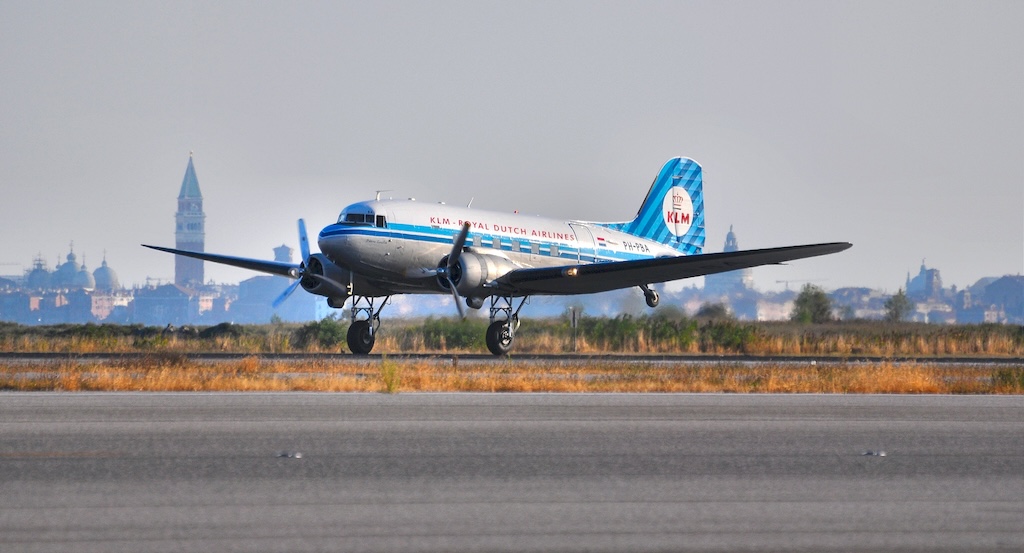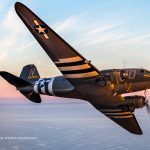by Paul van den Berg
On October 16, 2024 DDA Classic Airlines‘ DC-3 PH-PBA Princess Amalia shut down her engines for the last time with a full load of passengers at Schiphol Airport in Amsterdam. This marked the end of a 40 years long period of regular passenger operation with classic airliners in the Netherlands.

Founded in 1982 by two Transavia pilots, the all-volunteer DDA received the first DC-3, PH-DDA (former DO-7) from the Finnish Air Force in May 1984. Meanwhile, a solid technical department was formed by recently retired KLM certifying staff supported by younger enthusiasts eager to learn the ‘trade.’ Even before PH-DDA arrived, pilot ground training commenced and a complete airline-like organization was established with all related ground- and cabin staff. So from Summer 1984 and on, DDA-members were able to fly on scenic flights in ‘their’ DC-3 over the Netherlands and to air shows beyond. Much later, it was discovered that PH-DDA flew during D-Day for the USAAF in the 91th Troop Carrier Squadron with serial 42-100646, the very C-47 that carried 1st Lt. Dick Winters of 506 PIR ‘Easy Company,’ the Band of Brothers.

In 1986, a second DC-3, PH-DDZ (former SU-BFY) was purchased from Pyramid Airways, Egypt and in May ’87 a DDA-team traveled to Malta for an acceptance inspection and delivery flight to the Netherlands. Purpose of this second DC-3 purchase, named Doornroosje/ Sleeping Beauty’ was in fact her engines and components; PH-DDA would need the spares for continuous operation. PH-DDZ was built in 1944 and went into USAAF- and later USAF service until 1961. After a short FAA career, she went to Africa.

The original plan was to store Sleeping Beauty as she was until 2019, the 75th anniversary of the DC-3, but a few technicians couldn’t resist and slowly initiated some preservation and cleaning work. Soon the plan was altered to completely restore the DC-3 back to airworthiness. That took 12 years and when finished she was in a like-new condition, much of the skin replaced. A Douglas representative based at Schiphol visited DDA at one point and stated that “DDZ was the last new-build Douglas DC-3.” A tremendous compliment for those involved! Meanwhile it became clear that DDA could not be run by volunteers alone, and office manager Anneke, part-time DDA-stewardess, was full-time appointed to run the small ‘airline’ as a spider in the web, assisted by volunteers. In 1988, the fleet expanded with a Beechcraft D-18S (N5369X) an ex- Canadian Air Force example. The Beech was mainly used for tailwheel training for future DC-3 pilots and member-flights to airshows. Focusing more on Douglas-props, the Beech was finally sold in 1994 to the Royal Netherlands Air Force Historic Flight (RNHF), where she is still flying today.
DDA even bought a DC-2. In 1988, an ex-RAAF DC-2 A30-14 was shipped from Australia to the Netherlands on board a Navy vessel. The aircraft made its last flight in 1944 and had been stored outside ever since. Needless to say, it was in very bad shape but DDA had ambitious restoration plans. It was not to be. Manpower was drawn by the ongoing PH-DDZ restoration and PH-DDA operation. After many years of storage, the DC-2 was donated to the Dutch National Transport Museum in 2018, where she was cosmetically restored for a TV series.

Another purchase was Stinson L-5B Sentinel PH-PBB. This 1944-build trainer was the former personal transport of Prince Bernhard of the Netherlands, hence the ‘PB’ in the registration. At DDA it was primarily used for tailwheel training and pleasure flights. After many years of loan and caretaking by the RNHF, the Sentinel was donated to them in 2019.

The DDA grew bigger. In 1989, a hangar was built at Schiphol to house the two DC-3s, DC-2, Beech, and Stinson. Member and sponsor flights, air show visits, and special charters were flown and PH-DDA was a real money-maker. The search for Douglas transports didn’t stop: in 1995 DDA purchased two Douglas DC-4s in South Africa. Both were ex-SAAF aircraft and at that time relatively cheap to buy. The first to arrive was 1946-built DC-4-1009 Skymaster ZS-NUR, soon to become PH-DDS. The second one was ZS-IPR (PH-DDY), a C-54 from 1944, also ex-SAAF. PH-DDS arrived in Amsterdam in May 1996, after an extensive de-mob conversion into a 50 seat passenger configuration at Rand airport, South Africa. ZS-IPR arrived a year later and was mainly bought for (engine) spares.

Black Page
Disaster struck in September 1996 when PH-DDA crashed in the Waddenzee after an engine failure during the climb. All 32 occupants perished in the accident and DDA was in mourn. A huge blow for the association and a deep black page was written. In 1997, DDA did not fly.
DC-3 PH-PBA was taken up in the fleet in 1998, a true 1944 D-Day, Market Garden and Varsity -veteran and former Royal Transport. After the War, the surplus USAAF C-47 was acquired by Prince Bernhard for use as government and Royal family transport, often flown by himself. From 1960 until 1975 she was used by the Dutch CAA (RLD) for radio nav-aid calibration work. After her RLD-career, the DC-3 became obsolete and was taken up in the collection of the Aviodome museum at Schiphol airport. Her flying days were over, or so it seemed. She sat outside for a decade, then inside for another. When Prince Bernhard expressed the wish to have his old Dakota restored, that’s what happened. Restored in the UK, she was added to the DDA-fleet in spring 1998. One year later she was joined by an immaculately restored DC-3 PH-DDZ and three DDA-operated Douglas propliners.

Scaling Down
Around 2000, it was clear that the DC-4 had to go. The Skymaster could not be operated economically while CAA regulations were tightened. ZS-IPR was donated to the Aviodrome museum and PH-DDS went back to South Africa. For the next 16 years, DDA operated her two DC-3s and both were regular visitors to the main European airshows. But in 2016 KLM sponsorship ended and it was decided to operate only one DC-3 Dakota. The choice was on PH-PBA, mainly because of her impressive WWII and Royal career, obviously telling a good (marketing) story. PH-DDZ was to be sold to the Aviodrome Museum, much to the chagrin of her volunteer restorers. A sad day, but at least she remained in the Netherlands.

Princess
PH-PBA flew on and wore several different color schemes. During KLM-sponsorship she carried three classic KLM-liveries and was named Princess Amalia after the Dutch Crown Princess. In 2018 she was painted back in her original royal colors from the 50-ties. Meanwhile ‘DDA’ became ‘DDA Classic Airlines’ and gained an AOC.

The last years of DDA operation were very successful, apart from one year of storage during COVID. She was present during both ‘Daks over Normandy’ events in 2014 and 2019 and visited Normandy in other years as well, the last being two weeks in June 2024. Thousands of passengers from all over the world saw the invasion beaches and cemeteries from above from this D-Day veteran!

At the end of 2023, DDA management announced that 2024 would be the last season of DC-3 operation. Not able to secure long-term financial support, the increasing costs of hangarage, landing fees, and insurance had become too much of a financial burden for a volunteer organization like DDA Classic Airlines. Weeks after the ever-so-popular Market Garden flights in September the flying stopped and the Princess went into maintenance. During the DDA-Farewell meeting last October, it was revealed that the Aviodrome Aviation Museum at Lelystad Airport will purchase PH-PBA with the intention of keeping her airworthy and flying on a limited scale. There is no doubt that the museum will be supported by technical and operational DDA volunteers, all eager to keep ‘their’ Princess in the air where she belongs. For more information about the DDA Classic Airlines, visit www.dutchdakota.nl


































